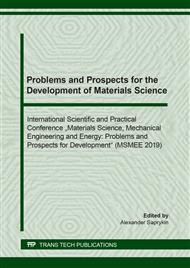p.7
p.14
p.20
p.26
p.32
p.37
p.43
p.51
p.57
Mechanism of Silicon Plate Decay in Aluminum Matrix under Electron Beam Effect
Abstract:
The decay mechanism of silicon particles in silumin in the thermal effect zone of low-energy high-current electron beam is proposed. Its essence consists in the fact that under the effect of the mechanical stresses the interface of silicon inclusion with aluminum matrix becomes instable resulting in the decay of silicon particle. It was supposed that the instability was the analog of Rayleigh-Taylor instability. The mechanical stresses arising due to the discrepancy of the elastic moduli and the linear expansion coefficients of the inclusion and the matrix are the analogs of gravity force. The analysis of the initial stage of instability within the frameworks of the visco-potential approximation has shown that the dependence of the rate of perturbations’ growth has only one maximum which falls on the wave length of the order ≈ 500 nm that is 5-fold higher than that of the experimental data. Such a discrepancy may be explained by the fact that when developing the model the temperature of the silicon inclusion and the aluminum matrix was considered to be constant, similar and being equal to the eutectic temperature of silumin. In fact, the temperatures of the inclusion and the matrix are different. To take into account the influence of these facts on the instability of the interface the new investigations are necessary.
Info:
Periodical:
Pages:
32-36
Citation:
Online since:
April 2020
Price:
Сopyright:
© 2020 Trans Tech Publications Ltd. All Rights Reserved
Share:
Citation:


